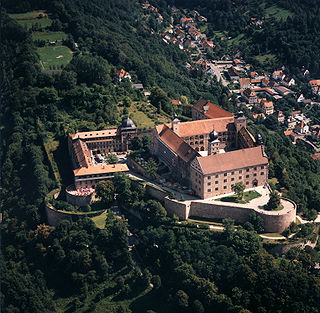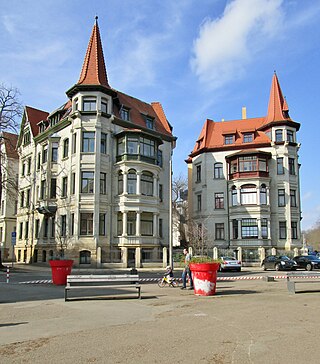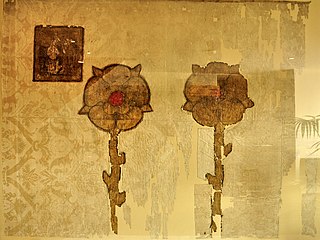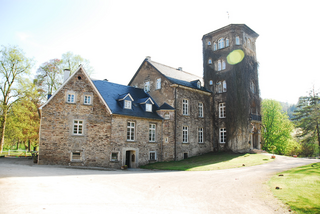
Wittringen Castle or Wittringen House (German: Schloss Wittringen or Haus Wittringen) is a moated castle in Gladbeck, North Rhine-Westphalia, Germany.

Wittringen Castle or Wittringen House (German: Schloss Wittringen or Haus Wittringen) is a moated castle in Gladbeck, North Rhine-Westphalia, Germany.

The noble family von Wittringen was first mentioned in an official document from 1263. Knight Ludolfus de Witteringe is today believed to have erected the castle around that time. The exact date is, however, unclear. Another document from 1394 mentions Heinrich von Brachtbecke as the castle's owner. The three Wolfsangeln of Brachtbecke's family crest were later also included in the crest of the city of Gladbeck.
In 1438, the Herzog of Cleves granted the von Oeffte family enfeoffment of 50 percent of Wittringen. The family later acquired the other half and was thus the castle's sole possessor for the next 150 years. In the mid-sixteenth century, Wittringen was given to the family of the Knights von Capellen as a betrothal gift. During the Thirty Years' War, it was plundered by Hessian troops in 1642.
In 1922, Freiherr Vittinghoff-Schell, then the owner of Wittringen, sold the castle to the city of Gladbeck. In the following years, it was extensively overhauled, using historic maps and plans. The manor house was re-modelled in its original style of the Dutch Renaissance. Since 1928, Wittringen has been home to the museum of Gladbeck (Museum der Stadt Gladbeck) and today it also hosts a restaurant. The castle is surrounded by spacious forests, parks and the Gladbeck Stadium.

Gladbeck is a town in the district of Recklinghausen in North Rhine-Westphalia, Germany.

Marienberg Fortress is a prominent landmark on the left bank of the Main river in Würzburg, in the Franconia region of Bavaria, Germany. It is a symbol of Würzburg and served as a home of the local prince-bishops for nearly five centuries. It has been a fort since ancient times, although most of the current structures were built in Renaissance and Baroque styles between the 16th and 18th centuries. After Gustavus Adolphus of Sweden conquered the area in 1631 during the Thirty Years' War, the castle was reconstructed as a Baroque residence. After it ceased to serve as residence of the Bishops of Würzburg, the fortress saw repeated action in the wars of the late 18th and 19th centuries. It was severely damaged by British bombs in March 1945 and only fully rebuilt in 1990. Today, it houses two museums.

Ramstein-Miesenbach is a town in the district of Kaiserslautern in Rhineland-Palatinate in Germany, adjacent to the U.S. Ramstein Air Base.

Roth is a town in Bavaria, Germany, the capital of the Roth District. It is located about 25 km south of Nuremberg.

Plassenburg is a castle in the city of Kulmbach in Bavaria. It is one of the most impressive castles in Germany and a symbol of the city. It was first mentioned in 1135. The Plassenberg family were ministerial of the counts of Andechs and used as their seat the Plassenburg. The House of Guttenberg, a prominent Franconian noble family, traces its origins back to 1149 with a Gundeloh v. Blassenberg (Plassenberg). The name Guttenberg is derived from Guttenberg and was adopted by a Heinrich von Blassenberg around 1310. From 1340, the Hohenzollerns governed from Plassenburg castle their territories in Franconia till 1604. The Plassenburg was fortress and residence for the Hohenzollerns.

Hilchenbach is a town in the Siegen-Wittgenstein Kreis (district) of North Rhine-Westphalia, Germany.

Waldeck Castle within the limits of the village of Dorweiler in Dommershausen in the Rhein-Hunsrück-Kreis (district) in Rhineland-Palatinate was the main seat of the Hunsrück family of Boos.

Rötteln Castle, located above the Lörrach suburb of Haagen, lies in the extreme southwest corner of the German state of Baden-Württemberg, just 10 kilometres north-east of the Swiss City of Basel. The fortification was one of the most powerful in the southwest, and today, it is the third largest castle ruin in Baden.

The Zunfthaus zur Haue or Haus zur Haue is situated at the Limmatquai promenade between Münsterbrücke and Rathausbrücke. It is the guild house of the Zunft zum Kämbel, meaning the guild of the merchants and traders. Neighbored by the Saffran, Zimmerleuten, and Rüden guild houses, it is one of the historically notable buildings in Zürich, Switzerland. The building also houses the relatively expensive restaurant of the same name.

Rapperswil Castle is a castle, built in the early 13th century by the House of Rapperswil, in the formerly independent city of Rapperswil.

Waldstraßenviertel, is a neighbourhood in the north west of Leipzig's borough Mitte in Saxony, Germany. It is considered one of the largest complete areas of Gründerzeit buildings in Europe and is therefore considered of important cultural and heritage status. Many of its buildings are therefore protected or listed.

Lissingen Castle is a well-preserved former moated castle dating to the 13th century. It is located on the River Kyll in Gerolstein in the administrative district of Vulkaneifel in Rhineland-Palatinate, Germany. From the outside it appears to be a single unit, but it is a double castle; an estate division in 1559 created the so-called lower castle and upper castle, which continue to have separate owners. Together with Bürresheim and Eltz, it has the distinction among castles in the Eifel of never having been destroyed.

The Veste Coburg is one of the best-preserved medieval fortresses of Germany. It is situated on a hill above the town of Coburg, in the Upper Franconia region of Bavaria.

Callenberg Castle is a schloss on a wooded hill in Beiersdorf, an Ortsteil of Coburg, 6 kilometres (3.7 mi) from the town centre. It was a hunting lodge and summer residence and has long been the principal residence of the House of Saxe-Coburg and Gotha. It is currently owned by Andreas, Prince of Saxe-Coburg and Gotha, who created the Ducal Saxe-Coburg and Gotha House Order. A large and architecturally important family chapel is contained within.

Herten Castle is a moated castle situated in the town of Herten in the administrative district of Recklinghausen in the state of North Rhine Westphalia, Germany. It is located within an old English landscape garden and its first mentioning dates back to 1376. In 1962, the main castle building was declared a cultural heritage monument.

The House of Rapperswil respectively Counts of Rapperswil ruled the upper Zürichsee and Seedamm region around Rapperswil and parts of, as of today, Swiss cantons of St. Gallen, Glarus, Zürich and Graubünden when their influence was most extensive around the 1200s until the 1290s. They acted also as Vogt of the most influential Einsiedeln Abbey in the 12th and 13th century, and at least three abbots of Einsiedeln were members of Rapperswil family.
The Regensberg family was a family of counts from the Canton of Zürich in Switzerland. They had possessions in the medieval Zürichgau from the probably mid-11th century and became extinct in 1331 AD. With the extinction of the male line, the city republic of Zürich laid claim to the Regensberg lands and formed the Herrschaft Regensberg respectively Äussere Vogtei.

Uster Castle is a hill castle which was built probably around 1200 AD by the House of Rapperswil in the Swiss municipality of Uster in the Canton of Zürich. Since 1995 it houses a boarding school.

Haus Bamenohl is a castle in the village of Bamenohl, municipality of Finnentrop, Olpe district in North Rhine-Westphalia, Germany.

The Schloss Jägerhof, formerly also called die Vénerie, is located at Jacobistraße 2 in Düsseldorf-Pempelfort, near the city centre. It was built between 1752 and 1763 by order of the Prince-elector Karl Theodor. At that time, the castle was still located outside the city gates. The palace is a point de vue of the Hofgarten riding avenue and the Jägerhofstraße. Since 1987, the castle has housed the Goethe-Museum and the Ernst Schneider Foundation.